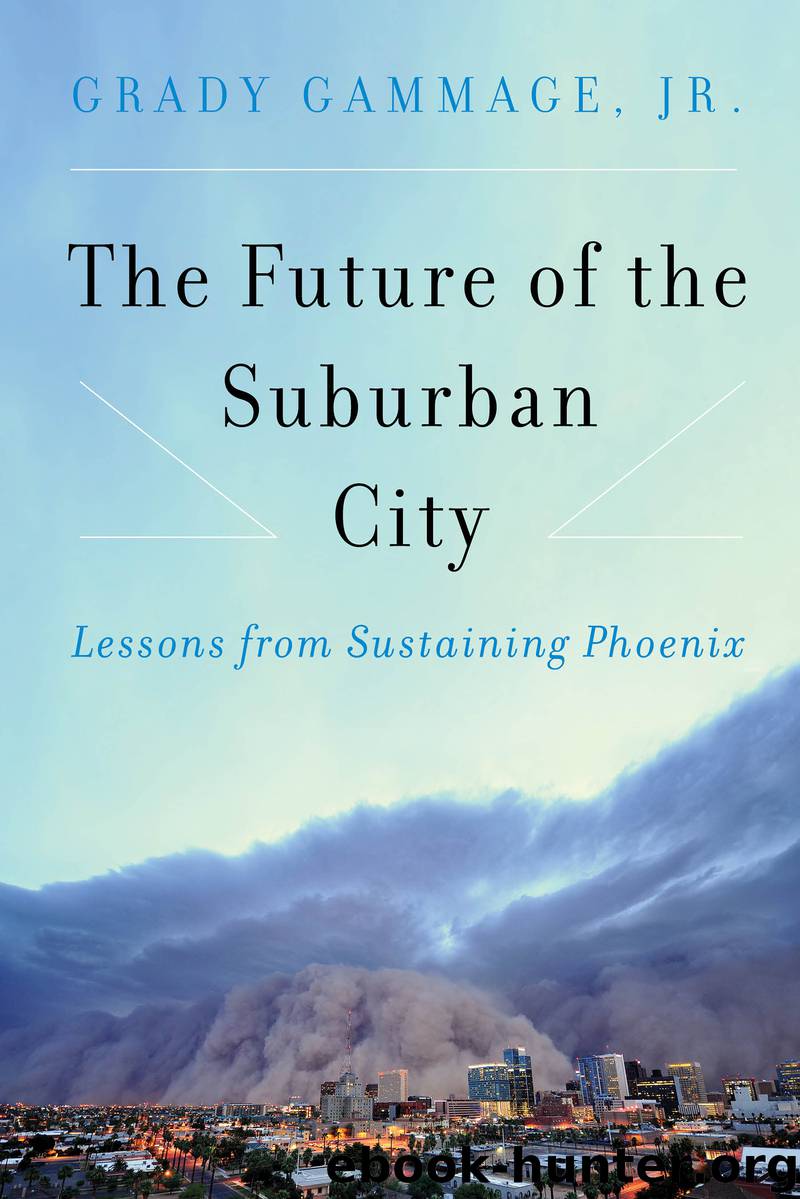The Future of the Suburban City by Grady Gammage Jr

Author:Grady Gammage Jr.
Language: eng
Format: epub
ISBN: 978-1-61091-624-0
Publisher: Island Press
Published: 2016-03-06T16:00:00+00:00
The two most pervasive postwar building forms in American architecture were the shopping center and the ranch house. Together, these building forms changed the nature of how cities grew and what they looked like. Shopping centers and ranch houses became the building blocks of metropolitan Phoenix and the suburban cities of the modern West.
Exactly what constitutes a shopping center, as opposed to a collection of individual shops, is open to interpretation. Today, the commonly accepted definition requires a group of architecturally unified buildings built on a site that is planned, developed, and managed as a single entity.16 Historically, the distinguishing characteristic of a shopping center has been highly visible and accessible parking shared by several different stores. When shopping became a motorized rather than a pedestrian activity, storefronts were ultimately pushed away from the street because the visibility of parking became more of an attraction than the visibility of merchandise. That single design change transformed the physical appearance of entire communities.
In Phoenix, an infatuation with visible surface parking came remarkably early, in the late 1920s. When the A. J. Bayless market chain opened its seventh store in March 1928, it set the building back thirty-five feet from the curb line in order to provide ample parking room for “several score” automobiles in a “provision which thus has been made for motoring shoppers [which] will prevent congestion of parked machines in [the] streets near the store.”17
Bayless’s new market was 8,000 square feet in size, the largest it had ever built and a good example of a growing phenomenon—the supermarket. From an early Piggly Wiggly self-service store in Memphis in 1916, the supermarket spread across America.18 After World War I, the average household was able to acquire a refrigerator, an appliance that revolutionized shopping habits. A housewife equipped with a refrigerator, and later with a freezer, was freed from having to shop every day. A weekly shopping trip meant there were too many bags to be carried at once, and a car was necessary to transport the groceries. The necessary parking meant that large supermarkets were not suited to downtown locations.
The supermarket became the anchor of the shopping center, which added an assortment of other often-frequented shopping destinations, all of which could be visited on a single trip. As suburban housing began to boom, the shopping center became an integral part of growth. In 1950, there were only 100 neighborhood shopping centers in the United States. By 1953, the number had tripled, and by 1960, there were 3,700.19
As Phoenix began its rapid annexation program, the national trend toward business and retail decentralization was in full swing. The intersections of two section-line arterial roads provided perfect locations for dispersed retail shopping centers, gas stations, and convenience restaurants. A development pattern began to emerge—a developer would acquire a quarter section or more of land and subdivide it for houses, holding out a ten-acre parcel on the corner for a shopping center. A commercial developer, often with a supermarket anchor tenant already committed, would build the center several years later.
Download
This site does not store any files on its server. We only index and link to content provided by other sites. Please contact the content providers to delete copyright contents if any and email us, we'll remove relevant links or contents immediately.
Kathy Andrews Collection by Kathy Andrews(11731)
The remains of the day by Kazuo Ishiguro(8826)
Paper Towns by Green John(5092)
Spare by Prince Harry The Duke of Sussex(5074)
Industrial Automation from Scratch: A hands-on guide to using sensors, actuators, PLCs, HMIs, and SCADA to automate industrial processes by Olushola Akande(4985)
The Body: A Guide for Occupants by Bill Bryson(4975)
Machine Learning at Scale with H2O by Gregory Keys | David Whiting(4185)
Be in a Treehouse by Pete Nelson(3951)
Never by Ken Follett(3794)
Harry Potter and the Goblet Of Fire by J.K. Rowling(3775)
Goodbye Paradise(3728)
Into Thin Air by Jon Krakauer(3313)
The Remains of the Day by Kazuo Ishiguro(3295)
The Cellar by Natasha Preston(3262)
The Genius of Japanese Carpentry by Azby Brown(3226)
Fairy Tale by Stephen King(3220)
120 Days of Sodom by Marquis de Sade(3184)
The Man Who Died Twice by Richard Osman(2997)
Drawing Shortcuts: Developing Quick Drawing Skills Using Today's Technology by Leggitt Jim(2996)
